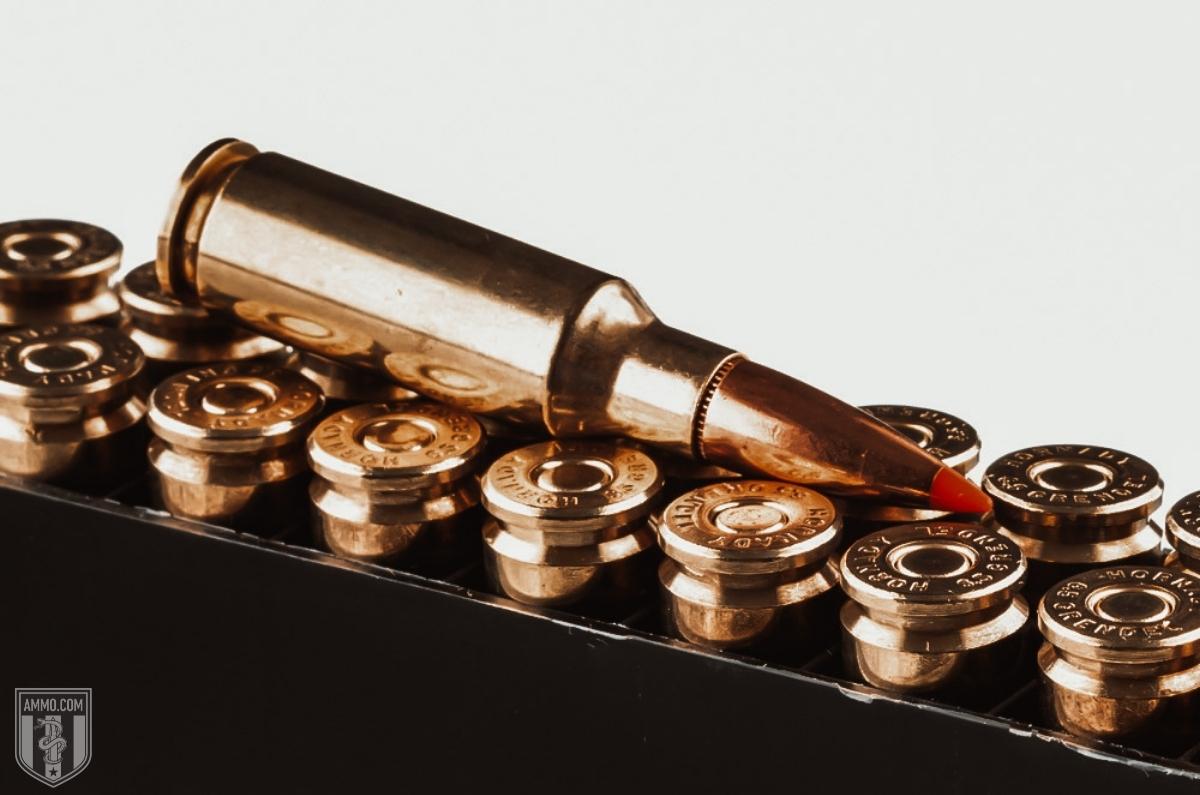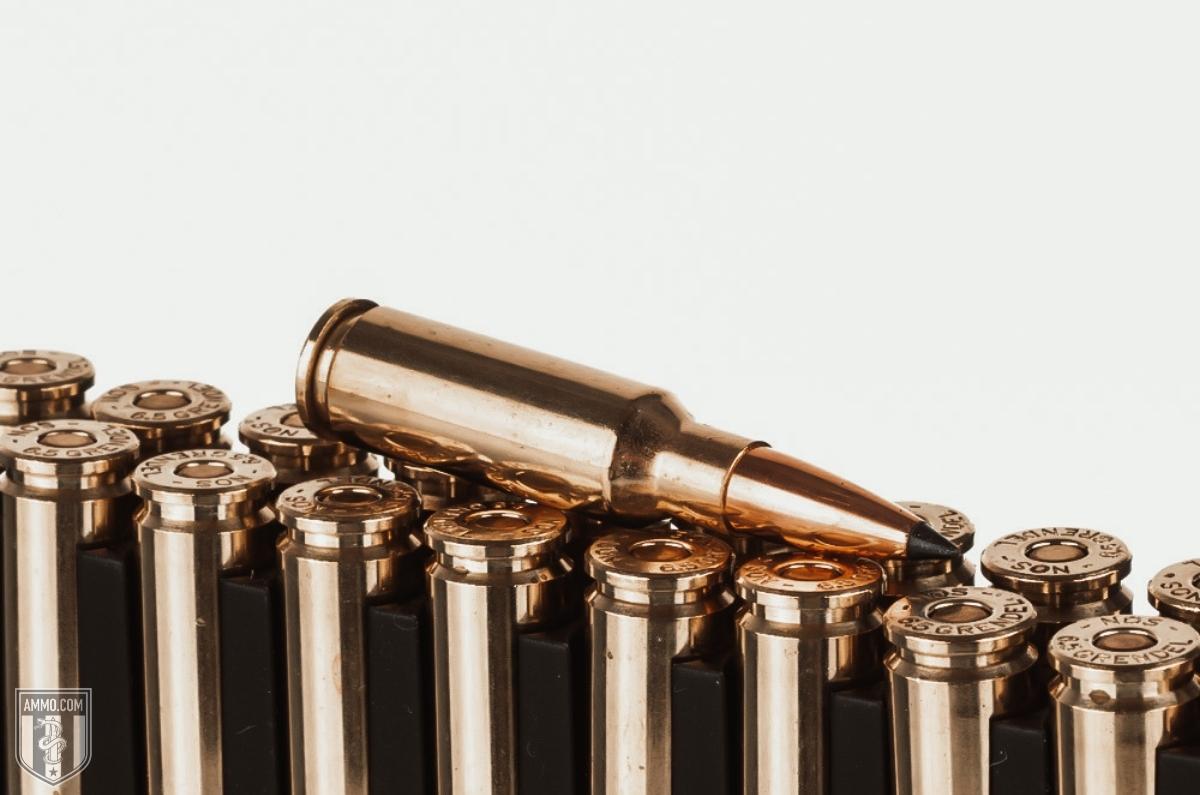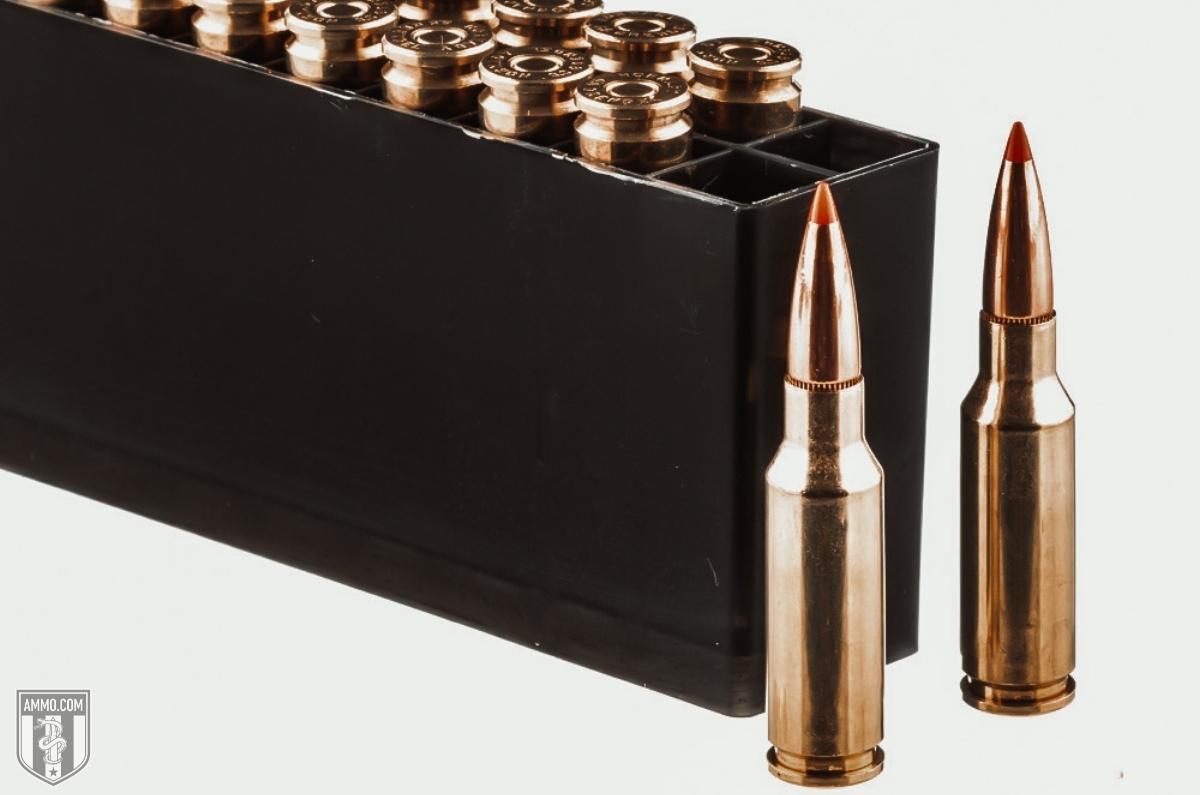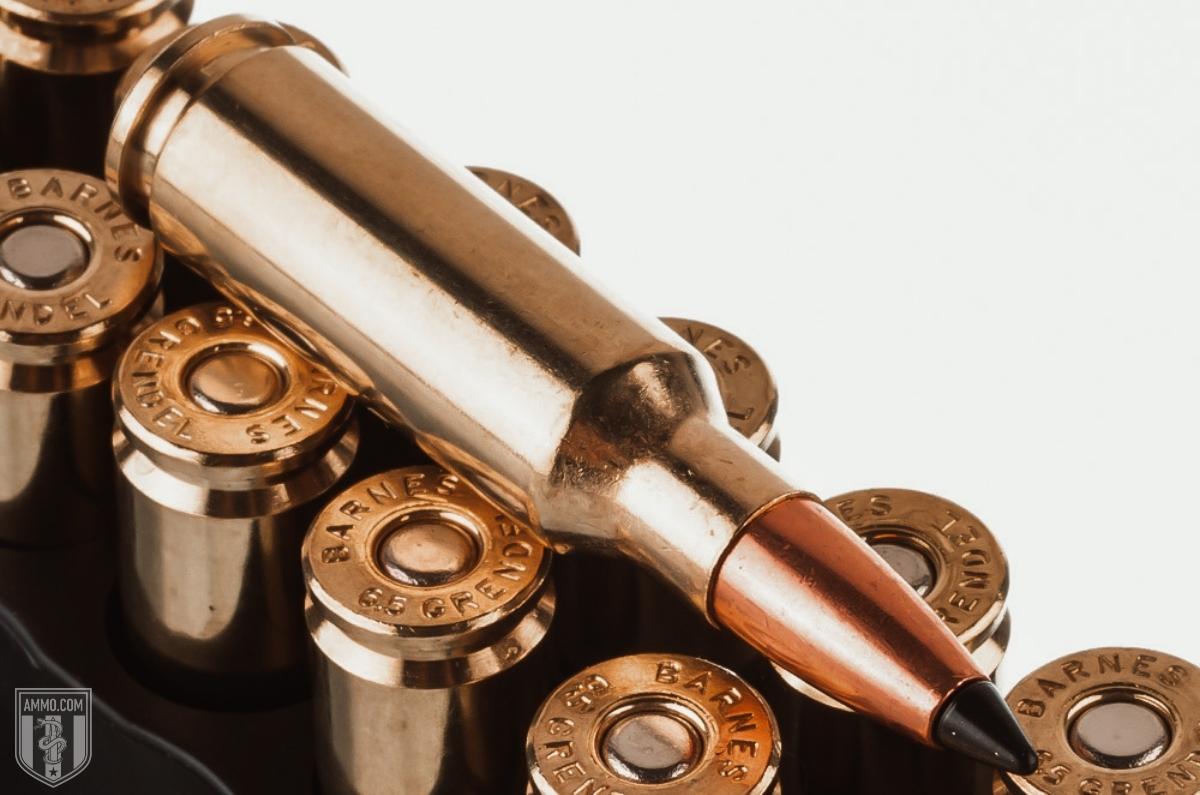6.5 Grendel vs 308: Comparing Long-Range Black Rifle Cartridges
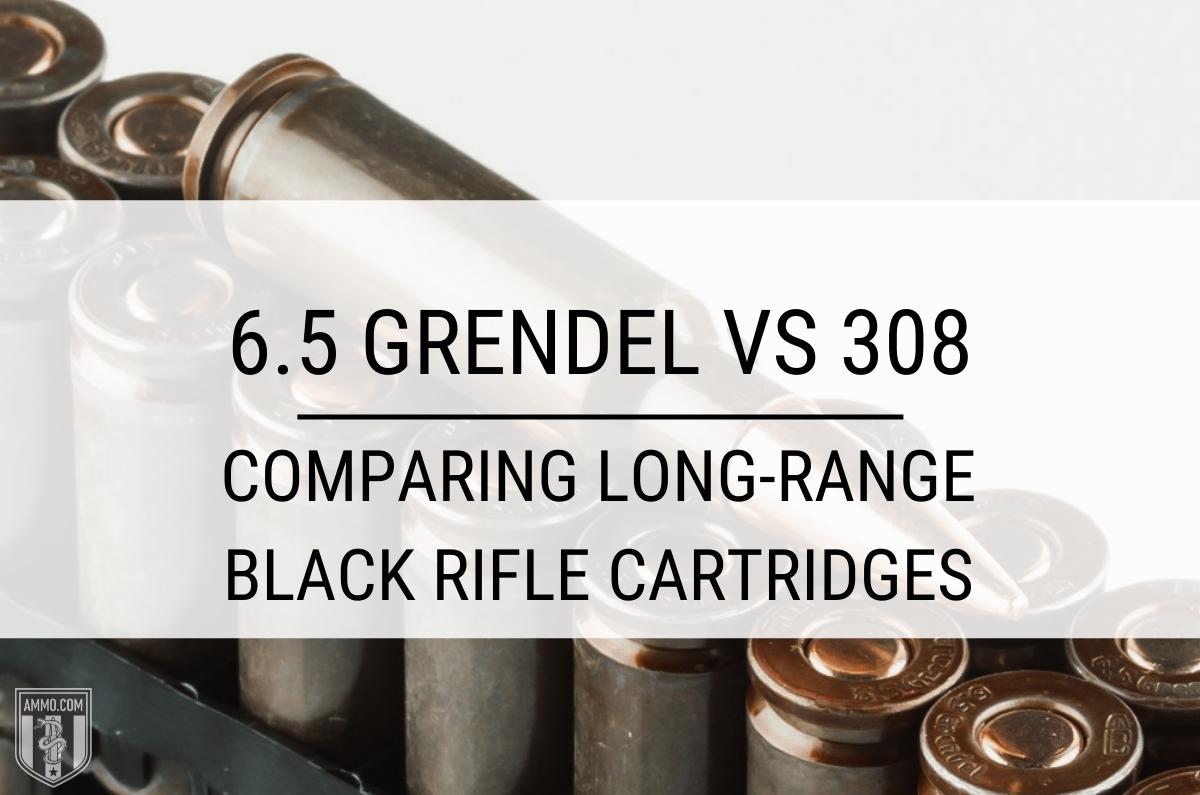 The 6.5 Grendel and 308 Winchester are two centerfire rifle cartridges that are utilized for hunting as well as long range target shooting.
The 6.5 Grendel and 308 Winchester are two centerfire rifle cartridges that are utilized for hunting as well as long range target shooting.
When shooters debate which cartridge is the better option, most will default to the argument of “Just buy a 308” as it is one of the most popular 30-caliber rounds on the market.
Although the 60+ year military, law enforcement, and hunting track record of the 308 is undeniable, the 6.5 Grendel offers several advantages over the 308 that should be considered. The 6.5 Grendel offers shooters comparable trajectory to the 308 with half the recoil and the ability to use the AR-15 platform as opposed to the more expensive AR-10 platform.
In this article, we will break down the nuances of the 308 vs 6.5 Grendel debate and help you make the best decision on which cartridge is best for your next hunting or target rifle.
What is the Difference Between 308 and 6.5 Grendel?
The differences between 308 Winchester and 6.5 Grendel are the diameter bullets each rifle cartridge fires, the overall case length, and felt recoil. The 308 Win fires 0.308” diameter projectiles compared to 0.264” for 6.5 Grendel. Furthermore, the 6.5 Grendel has a shorter case length and less recoil compared to the 308.
Cartridge Specs
When evaluating precision rifle cartridges tuned for longer ranges, it’s a good idea to analyze the cartridge specs to gain more knowledge of each.
The most prominent difference between these two rifle cartridges is the bullet they fire. The 308 Winchester fires the tried-and-true 0.308” diameter bullet. This is the same bullet diameter used by numerous popular 30-caliber cartridges like 300 Winchester Magnum, 30-06 Springfield, and 300 Blackout ammo. On the other hand, the 6.5 Grendel fires a 0.264” (6.71 mm) bullet like the 6.5 Creedmoor and 260 Remington. Generally, this means the 308 will fire heavier bullets than the 6.5 Grendel.
Another major difference between the 308 and 6.5 Grendel is their case length. The 6.5 Grendel is simply dwarfed by the massive 308 cartridge case by almost a half an inch. The 6.5 Grendel has a case length of 1.52” compared to 2.015” for 308. This directly reflects on the case capacity of both cartridges, as the 308 Win can handle up to 56 gr while the 6.5 can take on 35 gr of powder.
The difference in case capacity will affect the bullet weights each cartridge can fire. Typically, 6.5 Grendel will fire bullets between 90 and 130 grains, with a 123 grain bullet being the most popular. In contrast, the 308 Winchester can fire bullet weights between 110 and 200 grains as its cavernous case capacity has the power needed to fire heavier bullets at appropriate muzzle velocities.
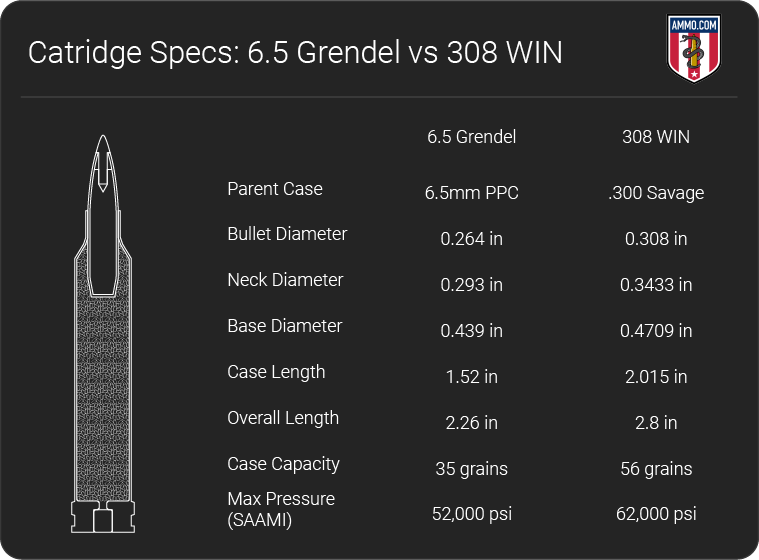
The next major difference between 308 and 6.5 Grendel is their overall length. As the 6.5 Grendel was developed to fit into the AR-15 platform and standard NATO magazines, its overall length is 2.26” just like the 223 Remington. As the 308 is not constrained by this magazine restriction and was developed for the heavier and more expensive AR-10, its overall length is considerably longer at 2.8”.
Lastly, the 308 Winchester can handle an additional 10,000 psi of pressure compared to the 6.5 Grendel. SAAMI specs establish the maximum pressure for 308 at 62,000 psi compared to 52,000 psi for the Grendel round.
Recoil
Based on the cartridge specs, it’s clear that the 308 is a bigger and beefier round. However, all that extra size, pressure, and case capacity comes at the cost of added recoil.
Felt recoil will be different between rifles, the bullet weight fired, and shooters. Therefore, for the purpose of this comparison we will use free recoil to determine the differences between 308 and 6.5 Grendel.
On average, the 308 Winchester will have around 20 ft-lbs of free recoil compared to 9 foot-pounds for the 6.5 Grendel.
This substantial discrepancy in free recoil is attributed to the differences in bullet weights and powder charges between the two cartridges.
As the 6.5 Grendel will generally fire lighter bullets with less powder, the 6.5 will have less felt recoil than the 308. Low recoil is a significant selling point for the 6.5 Grendel, as the lesser felt recoil decreases the potential for a shooter to develop a recoil flinch during long strings of fire.
Although recoil will vary between bullet weights and powder loads, the 6.5 Grendel will generally have half the recoil of 308.
Muzzle Velocity and Kinetic Energy
Muzzle velocity, measured in feet per second (fps) is the speed at which the bullet leaves the barrel of the firearm. Generally, a longer barrel length will generate a higher muzzle velocity because it allows for a more complete powder burn.
Muzzle energy is measured in foot-pounds (ft-lbs) and is a measurement of how much force a bullet delivers to its target at a given range.
The 308 Winchester and 6.5 Grendel will generally have similar muzzle velocities with a slight edge to the 308. However, the 308 is the clear winner when it comes to muzzle energy.
For this comparison, we will consider two popular long-range target shooting loads: the 175 gr 308 Win Federal Gold Medal Match and 123 gr 6.5 Grendel Hornady ELD Match. Both cartridges are capable of remaining supersonic out past 1,000 yards and are designed for sub-MOA long-range accuracy.
For muzzle velocity, the 308 Federal load will exit the barrel at 2,600 fps compared to 2,580 fps for 6.5 Grendel. This is essentially a wash as a 20 fps difference isn’t anything to write home about.
However, muzzle energy is a considerably different story.
The heavier bullets fired by the 308 are well known for their stopping power, and out 175 grain bullet will exit the barrel with 2,627 foot-pounds of force. Although the 6.5 Grendel is no slouch at 1,818 ft-lbs of muzzle energy, it just does not compare to the 308.
As you can see, the larger case capacity of the 308 allows it to push heavier projectiles at higher muzzle velocity and energy than the 6.5 Grendel.
Trajectory
Trajectory is how we quantify a bullet’s flight path as it travels downrange measured in inches of bullet drop.
Obviously, a flatter shooting cartridge is preferred for long-range shooting, as a shooter will require fewer adjustments to their optics to compensate for bullet drop. Having a flatter trajectory also means that a cartridge will be more forgiving of ranging mistakes.
One of the biggest selling points on 6.5mm bullets is their long, aerodynamic design that lends itself to a very flat shooting bullet. However, the military, law enforcement, and civilian shooters have been effectively using 30-caliber bullets for well over a century for long-range shooting. So, which one is better?
At 1,000 yards the 175 Sierra Matchking (SMK) 308 bullet has experienced -407” of bullet drop compared to -414” for the 123 gr Hornady ELD Match for 6.5 Grendel. Technically the 308 has the flatter trajectory, but this difference is so miniscule I’m calling it a wash between the two.
Ballistic Coefficient
Ballistic coefficient (BC) is a measure of how well a bullet resists wind drift and air resistance. Put another way, it’s a numeric representation of how aerodynamic a bullet is. A high BC is preferred as this means the bullet will buck the wind easier.
Generally, heavy bullets will have a higher ballistic coefficient as it takes more force to disrupt the flight of a heavier bullet than a lighter one. Ballistic coefficient varies from bullet to bullet based on design, weight, and other factors that are beyond the scope of this article.
With that in mind, you’d think that the 175 gr SMK for 308 would utterly dominate in terms of BC, but that would be an incorrect assumption.
One key component of ballistic coefficient calculations is bullet design, and the 6.5 mm bullet fired by the Grendel round is incredibly sleek and streamlined. Being more aerodynamic allows the 6.5 Grendel to fire lighter bullets but still maintain an excellent BC.
The 175 gr SMK has a ballistic coefficient of 0.505 while the 6.5 Grendel 123 ELD Match has a BC of 0.506.
Now you could look at those numbers and say that the two bullets are essentially equal in terms of ballistic coefficient, but that’s only half of the story.
If we look at other loads for 308 and 6.5 Grendel, we will see a different story.
Take for example two long range hunting rounds typically used on medium to big game, the 308 Win 165 gr Nosler Partition and 6.5 Grendel 123 gr Hornady SST. The 308 Nosler round has a BC of 0.410 while the 6.5 SST has a BC of 0.510.
Comparisons like this could go on ad infinitum, but except in a few circumstances, the more aerodynamic 6.5 Grendel will have a higher ballistic coefficient than the 308.
Sectional Density
Sectional Density (SD) is the measure of how well a bullet penetrates a target. This is extremely important when hunting big and medium sized game, as you need a bullet that can punch through thick hide, bone, and sinew.
Sectional density is calculated by comparing the bullet weight and the bullet diameter. The higher the SD the deeper the bullet will penetrate into the target. This is a simplified view of penetration as there are other factors to consider, such as bullet expansion and velocity.
Penetration is a ballistic measurement more pertinent to the big game hunting, therefore the 165 gr 308 Nosler Partition and 123 gr 6.5mm SST bullets will be compared.
In terms of sectional density, 308 Win and 6.5 Grendel are virtually identical. The 165 gr Partition bullet has a SD of 0.248 while the SST measures at 0.252.
Hunting
Choosing between the 308 Winchester and 6.5 Grendel for your new hunting rifle depends on what game animal and engagement ranges you expect. Both have incredible terminal ballistics that will make short work of any game animal that comes into your sights.
For varmints, the 6.5 Grendel is clearly the ideal choice. With its low recoil and semi-automatic capability in AR-15 rifles, a Grendel rifle offers you a lightweight package that is easy to carry and offers quick follow-up shots. Furthermore, you can utilize a shorter barrel, think 16-18”, without losing a lot of stopping power when using the 6.5 Grendel. The lighter bullets used in 6.5 Grendel ammo lend themselves to varmint hunting, with their high muzzle velocity and flatter trajectory.
For medium to large sized game like whitetail, the 6.5 Grendel is still a formidable cartridge and can easily take down deer out to 400 yards while retaining the recommended 1,000 ft-lbs of kinetic energy. A 6.5 Grendel could be used for elk within 100 yards, but anything larger and you’ll likely find yourself lacking the necessary muzzle energy to make a clean kill.
When you need to maintain kinetic energy over longer ranges, it is difficult to beat the 308 Winchester. There’s a reason it is has been one of the top long range hunting rounds in North America since it was released in the 1952. Able to retain the recommended 1,000 ft-lbs of energy to ethically harvest a whitetail out to 600 yards, the .308 offers a 50% increase in effective range over the Grendel. Furthermore, the 308 is more than up to the task for elk, moose, caribou, and black bear, making it an excellent big game hunting cartridge option rivaling the 300 Winchester Magnum and 30-06 Springfield.
Although there are some lighter weight loads for 308 that can be used for varmint hunting, most consider it “a bit much” for groundhogs, prairie dogs, or other varmints as a smaller cartridge can be used to similar effect, like the 223 Rem or in this case, 6.5 Grendel.
There is some overlap in the capabilities of 308 and 6.5 in terms of whitetail hunting, however the distinction between the two becomes clearer at the opposite ends of the hunting spectrum.
If you need a hard-hitting cartridge with impressive stopping power that can take down North America’s larger game at range, then the 308 is the clear choice. However, if you expect you’ll be felling mostly varmints and whitetail within 400 yards, then the 6.5 Grendel can do all of that with half the recoil of the 308.
Ammo and Rifle Cost/Availability
When it comes to ammo availability and cost, it is difficult to beat the 308 Winchester.
As the 308 is a military caliber that is currently in use, there is a plethora of surplus ammo and components available on the market at reasonable prices. Furthermore, steel cased ammo is also available from manufacturers like Wolf and Tula, which further drives down the price of 308.
Lastly, the 308 has been on the market since the early 1950’s and is extremely popular for hunting and long distance shooting, meaning that almost every ammo manufacturer like Remington, Federal, Hornady, Nosler, and Underwood has a 308 offering.
Brass cased full metal jacket (fmj) practice ammo for 308 will typically run you around $1/round with the Wolf steel cased ammo going for around $0.88/round. Premium hunting and match ammo generally runs around $2/round and up for 308 Win.
Buying in bulk is always smart, make sure to check out our stock of bulk 308 ammo.
As the 6.5 Grendel is a relatively new cartridge, there are fewer ammo options available for it compared to 308. Most Grendel ammo would be considered premium, as there are fewer sources of cheap practice ammo.
Wolf does offer a steel-cased version of the 6.5 Grendel for around $1/round, but from all other North American ammo manufacturers you should expect to pay no less than $1.70/round.
The 308 Winchester also wins again in the rifle department, due to its wide-spread adoption by military, law enforcement, hunters, and civilian long distance shooters alike.
Any rifle manufacturer worth their salt has a rifle chambered in 308, as it is one of the most popular centerfire rifle cartridges on the planet. The world is your oyster when it comes to bolt-action rifles as this is a staple in the hunting community. Furthermore, if you would prefer a semi-automatic rifle, you can easily pick up a Springfield M1A, an AR-10, a Kel-Tec RFB, FN-FAL, and even some AK-variants chambered in 7.62 NATO.
Sadly, the 6.5 Grendel has not received the fanfare and wide-spread acceptance that many had hope for, and this severely limits your rifle options. As it was developed for the AR-15 platform, it’s not hard to pick up a semi-automatic AR in 6.5 Grendel. However, these rifles typically carry a premium price tag that puts them on par with an out of the box AR-10 in terms of cost. At the time of writing, there were only two offerings for bolt-action rifles for 6.5 Grendel. Ruger and Howa are currently the only two major manufacturers offering a bolt-action Grendel rifle.
Reloading
The 308 Win and 6.5 Grendel are both excellent options for reloading and offer a wide variety of components for you to perfect your ideal handload with.
In general, 0.308” diameter bullets will be easier to come by as they are also shot from 300 Blackout ammo, 300 Win Mag, and 30-06 Springfield.
The 6.5mm craze has not hit North America as hard as it did in Europe, however the introduction of the 6.5 Creedmoor definitely aided in getting more 0.264” diameter bullets on the market. However, there are some 6.5mm cartridges that are popular to reload besides the Creedmoor and Grendel rounds, those being the 6.5x55mm Swiss and 260 Remington.
Generally, this means it will be easier to source components for the 308, as bullets for this caliber are more popular with North American handloaders, however you should still have plenty of options for 6.5mm projectiles as well.
In terms of powder, there are tons of options for both cartridges, so this will not be an issue.
However, as the 308 has a larger case capacity, you will burn through powder faster when you are reloading for this cartridge. Therefore, it is recommended to purchase your powders in bulk to increase your cost savings as well as not running out of powder before a long distance target shooting competition.
Ballistics: 308 vs 6.5 Grendel
Our team here at Ammo.com has spent countless hours scouring the Internet to bring you extremely comprehensive ballistics tables for both calibers. Below are tables that compare bullet weight to muzzle velocity, kinetic energy, and trajectory for both 6.5 Grendel vs 308.
6.5 Grendel Ballistics
Note: This information comes from the manufacturer and is for informational purposes only. The actual ballistics obtained with your firearm can vary considerably from the advertised ballistics. Also, ballistics can vary from lot to lot with the same brand and type load.
| 6.5mm Grendel Bullet WEIGHT | Muzzle VELOCITY (fps) | Muzzle ENERGY (ft. lbs.) | TRAJECTORY (in.) | |||||||||||
|---|---|---|---|---|---|---|---|---|---|---|---|---|---|---|
| Muzzle | 100 yds. | 200 yds. | 300 yds. | 400 yds. | Muzzle | 100 yds. | 200 yds. | 300 yds. | 400 yds. | 100 yds. | 200 yds. | 300 yds. | 400 yds. | |
| 123 Grain | 2590 | 2420 | 2256 | 2099 | 1948 | 1832 | 1599 | 1390 | 1203 | 1037 | 1.8 | 0 | -8.6 | -25.1 |
308 Winchester Ballistics
Note: This information comes from the manufacturer and is for informational purposes only. The actual ballistics obtained with your firearm can vary considerably from the advertised ballistics. Also, ballistics can vary from lot to lot with the same brand and type load.
| 308 Winchester Bullet WEIGHT | Muzzle VELOCITY (fps) | Muzzle ENERGY (ft. lbs.) | TRAJECTORY (in.) | |||||||||||
|---|---|---|---|---|---|---|---|---|---|---|---|---|---|---|
| Muzzle | 100 yds. | 200 yds. | 300 yds. | 400 yds. | Muzzle | 100 yds. | 200 yds. | 300 yds. | 400 yds. | 100 yds. | 200 yds. | 300 yds. | 400 yds. | |
| 55 Grain | 3770 | 3215 | 2726 | 2286 | 1888 | 1735 | 1262 | 907 | 638 | 435 | -2 | 1.4 | -3.8 | -15.8 |
| 110 Grain | 3165 | 2830 | 2520 | 2230 | 1960 | 2447 | 1956 | 1551 | 1215 | 938 | 1.4 | 0 | -6.9 | -20.9 |
| 120 Grain | 2850 | 2497 | 2171 | n/a | n/a | 2164 | 1662 | 1256 | n/a | n/a | 0 | -2.8 | n/a | n/a |
| 150 Grain | 2820 | 2533 | 2263 | 2009 | 1774 | 2648 | 2137 | 1705 | 1344 | 1048 | 2.5 | 0.4 | -8.5 | -26.1 |
| 150 Grain Superformance | 3000 | 2772 | 2555 | 2348 | 1962 | 2997 | 2558 | 2173 | 1836 | 1540 | 1.5 | 0 | -6.9 | -20 |
| 155 Grain | 2775 | 2553 | 2342 | 2141 | 1950 | 2650 | 2243 | 1887 | 1577 | 1308 | 1.9 | 0 | -8.3 | -24.2 |
| 155 Grain | 2850 | 2640 | 2438 | 2247 | 2064 | 2795 | 2398 | 2047 | 1737 | 1466 | 1.8 | 0 | -7.5 | -22.1 |
| 165 Grain | 2700 | 2440 | 2194 | 1963 | 1748 | 2670 | 2180 | 1763 | 1411 | 1199 | 2.5 | 0 | -9.7 | -28.5 |
| 168 Grain | 2680 | 2493 | 2314 | 2143 | 1979 | 2678 | 2318 | 1998 | 1713 | 1460 | 2.5 | 0 | -8.9 | -25.3 |
| 168 Grain Super Match | 2870 | 2647 | 2462 | 2284 | 2114 | 3008 | 2613 | 2261 | 1946 | 1667 | 1.7 | 0 | -7.5 | -21.6 |
| 170 Grain | 2000 | 1740 | 1510 | n/a | n/a | 1510 | 1145 | 860 | n/a | n/a | 0 | 0 | 0 | 0 |
| 178 Grain | 2620 | 2415 | 2220 | 2034 | 1857 | 2713 | 2306 | 1948 | 1635 | 1363 | 2.5 | 0 | -9.6 | -27.6 |
| 178 Grain Super Match | 2780 | 2609 | 2444 | 2285 | 2132 | 3054 | 2690 | 2361 | 2064 | 1797 | 1.8 | 0 | -7.6 | -21.9 |
| 180 Grain | 2620 | 2393 | 2178 | 1974 | 1782 | 2743 | 2288 | 1896 | 1557 | 1269 | 2.5 | -0.2 | -10.2 | -28.5 |
A Brief History of 6.5 Grendel
Ever since the adoption of the 223 Remington/5.56 NATO cartridge by the US armed forces, critics have questioned the combat effectiveness and terminal ballistics of the 22-caliber round.
As a result, several intermediate cartridges have been adapted to the AR-15 platform such as 300 Blackout ammo and 6.8 SPC in an attempt to bridge the gap between the 223 Reminton and 308 Winchester.
Never one to back down from a challenge, British/American armorer Bill Alexander of Alexander Arms debuted the 6.5 Grendel in May 2003 at the Blackwater training facility in North Carolina. Alexander Arms also utilized the services of competitive shooter Arne Brennan and senior ballistician Janne Pohjoispää of Lapua in development of the new rifle cartridge.
Bill Alexander was clearly a fan of mythology, as Grendel is the name of a monster in the British epic poem, Beowulf. Staying true to form, Alexander Arms also developed the 50 Beowulf cartridge for the AR-15 as well.
The goal of the 6.5 Grendel was to develop an intermediate cartridge that extended the effective range of AR-15 rifles out past 800 yards. Utilizing the same higher ballistic coefficient 0.264” diameter bullets used by the 6.5 Creedmoor, the 6.5 Grendel is capable or maintaining MOA-level accuracy and supersonic velocities out to 1,200 yards with half the recoil of the 308 Win.
Descended from the 6.5mm PPC, which itself was developed from the 220 Russian and 7.62x39mm, the 6.5 Grendel has a wider case head than the 223 Remington and requires a non-standard AR-15 bolt and specialized magazines for use in AR-15 rifles.
Wide-spread adoption of the 6.5 Grendel was somewhat hindered by Bill Alexander himself, as he insisted that the cartridge be trademarked, and therefore could not be standardized by SAAMI. However, Alexander Arms in collaboration with Hornady Ammunition, registered the 6.5 Grendel with SAAMI in 2010. This allowed other manufacturers to create and sell 6.5 Grendel ammo, greatly expanding the reach of the cartridge.
As the 6.5 Grendel is still a relatively new cartridge on the market, it has developed a stalwart following in the shooting community who enjoy the terminal ballistics of a 308 Win without having to upgrade to an AR-10.
Although the 6.5 Grendel has not yet been adopted by the US military, the Serbian military is currently conducting tests in accordance with adopting the 6.5 Grendel in their new M17 Zastava battle rifles.
With exceptional long range capability, barrel life, and MOA-level accuracy, the 6.5 Grendel is an excellent choice if you’re looking to upgrade your AR-15 platform to something that has a bit more stopping power than a 223 Rem.
A Brief History of 308 Winchester
The development of the 308 Winchester (military designation - 7.62x51mm NATO) began after the Korean War to replace the long-serving 30-06 Springfield round.
In 1954, the military officially adopted the 7.62x51mm NATO as their new cartridge and it saw limited service in Vietnam before being replaced by the 5.56x45mm NATO (223 Rem).
Winchester quickly saw the utility of the 7.62x51mm NATO round on the civilian market and introduced the new rifle cartridge as the 308 Winchester in its short action Model 70 rifle in 1952, two full years before the U.S. Military formally adopted the cartridge.
The 308 Winchester was almost an immediate commercial success for its astounding accuracy, stopping power, and an effective range out to 1,000 yards (with appropriate loadings). Since the 1950’s and even up to this day, the 308 Win has been a staple in deer hunting camps and in marksmanship competitions across the globe.
One of the appeals of the 308 Winchester for big game hunting is its versatility in bullet weight, typically ranging between 120 to 180 grains.
Although the 6.5 Creedmoor and the 300 Win Mag are becoming more popular in the hunting and precision shooting circles, there is no shortage of shooters who swear by and will never let go of their beloved 308 Winchester.
If you’d like to learn more about how the 308 Win compares to other calibers, check out these articles below:
- 308 vs 5.56
- 6.5 Creedmoor vs 308
- 300 Blackout vs 308
- 300 Win Mag vs .308
- 243 vs 308
- 30-06 vs 308
- 7mm-08 vs 308
- 270 vs 308
- 7.62x39 vs 308
- 223 Rem vs 308
- 338 Lapua vs 308
Final Shots: 6.5 Grendel vs 308
The debate over 6.5 Grendel vs 308 primarily centers around your preferred rifle and what targets you intend to engage.
The 308 Winchester is a battle-proven cartridge that can deliver crushing kinetic energy into its targets at longer distances. Its downrange performance is nothing short of spectacular and this is one of the reasons it has been one of the top long range hunting rounds on the planet for well over 50 years.
The 6.5 Grendel offers long range target shooters a cartridge that can outperform the 308 past 1,000 yards with half the recoil. It is also an extremely potent deer cartridge inside 400 yards and was developed for the less expensive AR-15 platform.
If you’re planning on hunting big game like elk, moose, and black bears, then it’s hard to beat the kinetic energy offered by the 308. Furthermore, if your state or territory requires the use of bolt-action rifles for hunting, then there are considerably more options available for 308.
However, if you’re looking to upgrade your AR-15 and extend its effective range, stopping power, and trajectory, then you will be hard pressed to find a better option than the 6.5 Grendel.
Its streamlined bullets and higher ballistic coefficient are a hands down improvement over the 223 Remington and allows shooters to take their AR-15 deer hunting in most localities.
Whichever cartridge you choose, make sure that you get all your ammo here at Ammo.com and we’ll see you out on the range!
Ammo Comparisons
- .308 vs 5.56
- 6.5 Creedmoor vs .308
- .300 Blackout vs .308
- .300 Win Mag vs .308
- .243 vs .308
- .308 vs .30-06
- 7mm-08 vs .308
- .270 vs .308
- 7.62x39 vs .308
- .223 vs .308
- .338 Lapua vs .308
- .380 ACP vs 9mm
- .223 vs 5.56
- .300 Blackout vs 5.56
- 9mm vs 45 ACP
- 9mm vs 40 S&W
- .357 SIG vs 9mm
- 10mm vs 9mm
- 9mm vs 9mm Luger
- .243 vs .270
- .300 Win Mag vs .30-06
- .270 vs .30-06
- .40 vs .45
- 38 Special vs 357
- 9mm vs 40 vs 45
- 5.56 vs 7.62x39
- 338 Lapua vs .30-06
- .30-30 vs .30-06
- 300 PRC vs 338 Lapua
- .30-06 vs 7mm
- 300 Win Mag vs 338 Lapua
- 300 PRC vs 300 Win Mag
- 300 WSM vs 300 Win Mag
- 338 Win Mag vs 338 Lapua
- 12 Gauge vs 20 Gauge
- 10mm vs 357 Mag
- .30-30 vs 7.62x39
- 224 Valkyrie vs 22-250
- 17 HMR vs 22 Mag
- 7.62x39 vs .300 Blackout
- 45 ACP vs 45 Auto
- 45-70 vs 30-30
- 300 Blackout vs 223
- 357 Magnum vs 9mm
- 350 Legend vs 300 Blackout
- 224 Valkyrie vs 223
- 45 ACP vs 38 Super
- 6.5 Grendel vs .308
- 17 HMR vs 22 LR
- 10 Gauge vs 12 Gauge
- 22-250 vs 223
- 45 Colt vs 45 ACP
- 350 Legend vs 30-30
- 5.7x28 vs 223
- 5.7 vs 9mm
- 5.56 vs 5.7
- 22 vs 9mm
- Buckshot vs Birdshot
- 450 Bushmaster vs 308
- 450 Bushmaster vs 223
- Buckshot vs Slug
- 6.5 Grendel vs 5.56 vs 223
- 6mm ARC vs 6.5 Grendel
- 44 vs 45
- 458 SOCOM vs 5.56
- 357 vs 44
- 32 ACP vs 380
- 300 Win Mag vs 338 Win Mag vs 338 Lapua Mag
- 450 Bushmaster vs 458 SOCOM vs 50 Beowulf
- 6mm Creedmoor vs 6.5 Creedmoor
- TMJ vs FMJ
- 44 Special Vs 44 Magnum
- 45 90 vs 45 70
- 6.8 Western vs 6.8 SPC
- 50 Beowulf vs 50 BMG
- 26 Nosler vs 6.5 PRC
- 28 Gauge vs 410
- 6.8 SPC vs 5.56
- 6.8 SPC vs 6.5 Grendel
- 6.8 Western vs 7mm Rem Mag vs .28 Nosler
- 6.8 Western vs 6.5 Creedmoor
- 22 Hornet vs 223
- 6.8 Western vs 6.5 PRC
- .410 vs 12 Gauge
- .410 vs 20 Gauge
- 22 LR vs 22 Mag
- 6mm ARC vs 243
- 7mm-08 vs 270
- 243 vs 6.5 Creedmoor
- Nickel vs Brass Casing
- 204 Ruger vs 223
- 50 Beowulf vs 5.56
- 260 Remington vs 6.5 Creedmoor
- 6mm Remington vs 243
- 28 Nosler vs 300 PRC
- 50 Beowulf vs 50 AE
- 22 Nosler vs 22-250
- 450 Marlin vs 45-70
- 300 Win Mag vs 300 Norma
- 458 SOCOM vs 300 Blackout
- 38-55 vs 45-70
- 22 Hornet vs 22 LR
- 300 Norma vs 338 Lapua
- 338 Lapua vs 50 BMG
- 28 Nosler vs 300 Win Mag
- 28 Nosler vs 6.5 Creedmoor
- 204 vs 22-250
- 458 SOCOM vs 45 70
- 44 40 vs 45 70
- 6.8 SPC vs 6.5 Creedmoor
- 450 Bushmaster vs 30-06
- 7mm Rem Mag vs 300 Win Mag
- 30 Carbine vs 223
- 25-06 vs 30-06
- 26 Nosler vs 28 Nosler
- 16ga vs 12ga
- 30 06 vs 7.62 x54R
- 9mm Makarov vs 9mm Luger
- 350 Legend vs 223
- 30 Carbine vs 5.56
- 6.5x55 vs 6.5 Creedmoor
- 6.5 Creedmoor vs 270 vs 25-06
- M193 vs M855
- 450 Bushmaster vs 458 SOCOM
- 6.5 Grendel vs 6.5 Creedmoor
- 350 Legend vs 5.56
- .277 Fury vs 6.8 SPC
- 277 Fury vs 300 Win Mag
- 10mm vs .45 ACP
- 277 Fury vs 223
- 6.8 SPC vs 300 Blackout
- 6.5 PRC vs 6.5 Creedmoor
- 277 Fury vs 308
- 277 Fury vs 6.5 Creedmoor
- 350 Legend vs 450 Bushmaster
- 277 Fury Vs 5.56 NATO
- 10mm vs 40S&W
- 32 ACP vs 9mm
- 32 Special vs 9mm
- 8.6 Blackout vs 300 Blackout
- 30 Super Carry vs. 9mm
- 5.56 vs 9mm
- .50 Action Express vs 9mm
- 7.62x25 vs. 9mm
- 10mm vs 44 Magnum
- 300 Blackout vs 300 Win Mag
- 6.5 Grendel vs 300 Blackout
- 460 Rowland vs 10mm
- 300 RUM vs 300 PRC
- 300 Norma vs 300 PRC
- 45 GAP vs 45 ACP
- 7mm PRC vs 300 Win Mag
- 300 PRC vs 6.5 Creedmoor
- 300 PRC vs 308
- 357 SIG vs 357 Mag
- 7.62x39 vs 7.62x51
- 243 Win vs 223 Rem
- 30 Nosler vs 300 PRC
- 6.5 Creedmoor vs. 30-06 Springfield
- 450 S&W vs. 44 Magnum
- 6.5 Creedmoor vs. 300 Win Mag
- 454 Cassull vs. 45-70 Govt
- 454 Cassull vs. 44 Mag
- 7.62x54r vs. 308 Winchester
- 22 ARC vs. 223 Rem
- Subsonic vs. Supersonic Ammo
